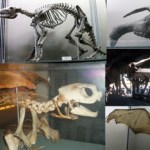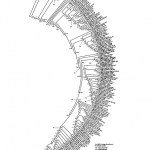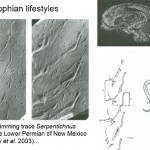Palaeozoic tetrapods
I said I wouldn't do any conferences this year. But I lied, and have recently returned from the 58th Symposium on Vertebrate Palaeontology and Comparative Anatomy (SVPCA), this year held once again in Cambridge, UK. Compared to the enormous, sprawling SVP (= Society of Vertebrate Paleontology) meeting with its numerous concurrent sessions (last year held in England, but usually held in North America), SVPCA is tiny and tidy. So, ok, there's less content, but at least you get to talk to everyone you want to, and to go to all the talks. As usual, I had an excellent time and extend warm thanks…
First of all, here are some temnospondyls. This composite image was compiled by repositioning the reconstructions provided by DeFauw (1989): looks neat, doesn't it?
So, I recently returned from the 69th Society of Vertebrate Paleontology meeting, this year held in Bristol, UK: in other words, OUTSIDE OF NORTH AMERICA for the first time ever. It was combined with another meeting I normally attend, SVPCA (Symposium on Vertebrate Palaeontology and Comparative Anatomy), but I think that people sometimes forgot about this. The meeting was enormous and the sheer quantity of talks and posters, and…
I promised myself back in 2007 that I'd cut down on the number of conferences I attend. There's a problem with that: I'm pretty bad at keeping promises (at least, to myself). This year I'm attending a ridiculous four conferences, and I've just returned from the first of them (please remind me why I have no money, and no spare time). Entitled Sea Dragons of Avalon: the early radiations of the marine reptiles and recovery from the Triassic-Jurassic faunal crisis, with special reference to Street in Somerset and the wider British record, this Palaeontological Association (Pal Ass) seminar…
At some stage, I'll have to write full-length articles on lysorophians, aïstopods, the remaining temnospondyls, nectrideans, microsaurs, and assorted other groups of Palaeozoic and Mesozoic non-amniote tetrapods. Alas, this hasn't happened yet. In the meantime, here are some slides from one of my talks...
Lysorophians are peculiar, long-bodied lepospondyls from the Carboniferous and Permian, best known for Brachydectes. They had strongly reduced limbs and limb girdles and elongate skulls, typically with a strongly emarginated cheek region. Trace fossils suggest that some species were…
2007 - Tet Zoo's second year of operation - has come and gone. The previous article was a brief personal review of the year, and here's more of the same (sort of) if you can handle it...
As if Tet Zoo wasn't enough to deal with, in September my partners-in-crime Mike P. Taylor and Matt Wedel [shown here; Mike is the less big one] decided, with me, to start up a new zoological blog, but this time devoted to something a little more specific: namely, sauropod vertebrae (and nothing else, pretty much). So on October 1st, Sauropod Vertebra Picture of the Week, or SV-POW!, was born. Despite…
Among the many, many groups I have yet to cover on Tet Zoo are stem-group synapsids: Synapsida is the tetrapod clade that includes mammals and all of their relatives, and there is a long tradition of referring to non-mammalian synapsids as 'mammal-like reptiles' (other names include protomammals and paramammals). Because synapsids are not part of Reptilia*, referring to them as 'mammal-like reptiles' is both technically incorrect and misleading, hence the push to use their proper name.
* Reptilia and Synapsida are sister-taxa within the tetrapod clade Amniota.
The photo here was provided by…
At last, I fulfill those promises of more temnospondyls. Last time we looked at the edopoids, perhaps the most basal temnospondyl clade: here we look at the rest of the basal forms. Scary predators, marine piscivores, late-surviving relics, and some unfortunate beasts burned alive in forest fires...
Studies on temnospondyl phylogeny mostly agree that 'post-edopoid' temnospondyls form a clade, the most basal members of which include Capetus, Dendrerpeton and Balanerpeton (Milner & Sequeira 1994, 1998, Holmes et al. 1998, Ruta et al. 2003a, b) [though some workers have found some of these…
Today I submitted another one of those long-delayed manuscripts. Yay. I also got to work preparing one of the three conference talks I'm supposed to be giving this year - how the hell I'm going to pull off all three I'm not sure. Anyway, leaving well alone the whole picture-of-the-day debacle, it's time for a proper post. Last time we looked at the edopoids, one of the most basal clades of temnospondyls, and in the next post I plan to write about some of the other basal temnospondyls.
Ever trying to recycling old text that sits, un-used, on disks, drives and memory-sticks, here I'm going to…
Like plethodontid salamanders, Wealden dinosaurs, and rhinogradentians, the remarkably successful and diverse tetrapods known as temnospondyls have been riding the Tet Zoo wagon right since the earliest posts of ver 1. But, to my shame, I've never gotten round to completing one of the ten or so posts that I plan to publish on them. If you're interested in tetrapod evolutionary history and haven't heard of temnospondyls before, it's time to get learning, as they were one of the most diverse, abundant and ecologically significant tetrapod groups of the Palaeozoic and early Mesozoic [adjacent…



